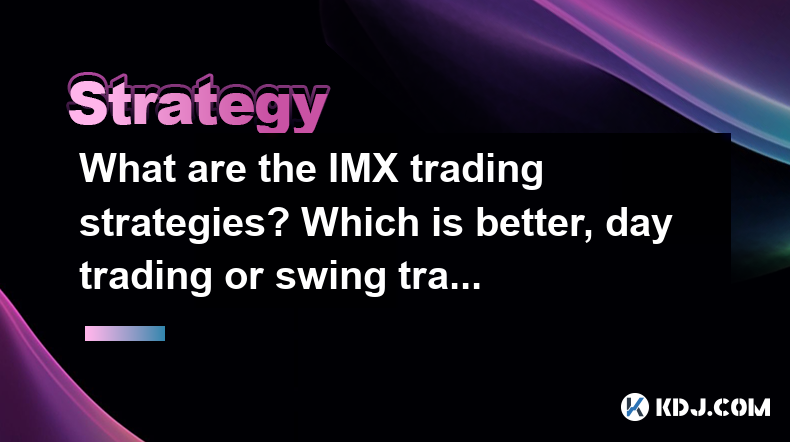-
 bitcoin
bitcoin $122659.385674 USD
0.52% -
 ethereum
ethereum $4484.113342 USD
-0.09% -
 bnb
bnb $1304.229256 USD
-0.85% -
 tether
tether $1.000204 USD
-0.03% -
 xrp
xrp $2.860636 USD
-0.51% -
 solana
solana $227.288799 USD
2.36% -
 usd-coin
usd-coin $0.999805 USD
0.01% -
 dogecoin
dogecoin $0.252837 USD
1.18% -
 tron
tron $0.341149 USD
1.12% -
 cardano
cardano $0.830507 USD
0.33% -
 hyperliquid
hyperliquid $45.792319 USD
0.04% -
 chainlink
chainlink $22.422164 USD
1.55% -
 ethena-usde
ethena-usde $1.000283 USD
0.01% -
 sui
sui $3.511389 USD
0.83% -
 stellar
stellar $0.385276 USD
-0.44%
What are the IMX trading strategies? Which is better, day trading or swing trading?
Day trading IMX involves quick, same-day trades, while swing trading holds positions for days to weeks; choose based on your time and risk tolerance.
May 01, 2025 at 08:14 am

When it comes to trading IMX, or Immutable X, a layer-2 scaling solution for Ethereum focused on NFTs, traders employ various strategies to maximize their returns. Two of the most popular strategies within the cryptocurrency trading community are day trading and swing trading. This article will delve into these strategies, explaining their mechanics, benefits, and drawbacks, and help you determine which might be better suited for your trading style.
Understanding IMX
Before diving into the trading strategies, it's crucial to understand what IMX is. Immutable X is a layer-2 scaling solution built on Ethereum, designed to enable fast and gas-free NFT transactions. It's particularly popular among traders and collectors of digital assets. Given its focus on NFTs and its potential for rapid price movements, IMX presents unique opportunities for traders.
Day Trading IMX
Day trading involves buying and selling IMX within the same trading day, aiming to capitalize on short-term price movements. This strategy requires a high level of attention and quick decision-making.
Monitor the Market: Day traders need to keep a close eye on IMX's price movements throughout the day. This can be done using real-time charts and trading platforms that offer live data.
Technical Analysis: Utilize technical indicators like moving averages, RSI, and MACD to identify potential entry and exit points. For instance, if the RSI indicates IMX is overbought, it might be a good time to sell.
Set Stop-Loss Orders: To manage risk, set stop-loss orders. For example, if you buy IMX at $1.00, you might set a stop-loss at $0.95 to limit potential losses.
Leverage: Some day traders use leverage to amplify their returns. However, this also increases the risk, so it should be used cautiously.
Quick Execution: Day trading requires quick execution of trades. Delays can result in missed opportunities or increased losses.
The advantage of day trading IMX is the potential for quick profits. However, it requires significant time and can be stressful due to the need for constant monitoring and quick decision-making.
Swing Trading IMX
Swing trading involves holding IMX for several days to weeks, aiming to profit from medium-term price swings. This strategy is less time-intensive than day trading and can be more suitable for those with less time to devote to trading.
Analyze Trends: Swing traders focus on identifying trends that may last several days or weeks. This involves looking at longer-term charts and using indicators like moving averages to spot potential trends.
Entry and Exit Points: Determine entry points based on trend analysis. For example, if you notice IMX is consistently bouncing off a certain support level, you might enter a trade when the price approaches this level.
Risk Management: Like day trading, setting stop-loss orders is crucial. However, swing traders might set wider stop-losses due to the longer holding period.
Fundamental Analysis: In addition to technical analysis, swing traders might consider fundamental factors affecting IMX, such as new partnerships or developments in the NFT space.
Patience: Swing trading requires patience, as it can take time for the anticipated price movements to occur.
The advantage of swing trading IMX is that it's less time-consuming and can be less stressful than day trading. However, it requires patience and the ability to withstand potential short-term losses.
Comparing Day Trading and Swing Trading for IMX
Both day trading and swing trading have their merits and drawbacks when applied to IMX. The choice between the two often depends on your trading style, time commitment, and risk tolerance.
Time Commitment: Day trading requires constant monitoring throughout the trading day, making it suitable for those who can dedicate significant time to trading. Swing trading, on the other hand, allows for less frequent monitoring, making it more suitable for those with other commitments.
Risk and Reward: Day trading can offer quick profits but also comes with higher risk due to the need for quick decision-making and potential for sudden price swings. Swing trading typically involves lower risk per trade but requires patience and the ability to withstand short-term losses.
Skill Set: Day trading demands a strong grasp of technical analysis and the ability to act quickly. Swing trading requires a good understanding of both technical and fundamental analysis, as well as patience.
Capital Requirements: Day trading often requires more capital due to the need for frequent trades and potential use of leverage. Swing trading can be done with less capital, as trades are held for longer periods.
Which Strategy is Better for Trading IMX?
Determining whether day trading or swing trading is better for IMX depends on your individual circumstances. If you have the time and temperament to monitor the market closely and make quick decisions, day trading might be more suitable. It can offer quick profits and the excitement of fast-paced trading.
On the other hand, if you prefer a less time-intensive approach and are willing to hold positions for longer periods, swing trading could be more appropriate. It allows for more flexibility and can be less stressful, though it requires patience and a longer-term perspective.
Implementing Your Chosen Strategy
Once you've decided on a strategy, the next step is to implement it effectively. Here are some tips for both day trading and swing trading IMX:
- For Day Trading:
- Use a reliable trading platform that offers real-time data and quick execution.
- Start with smaller trades to get a feel for the market and refine your strategy.
- Keep a trading journal to track your performance and learn from your trades.
- For Swing Trading:
- Set clear entry and exit points based on your analysis.
- Stay informed about developments in the NFT and Ethereum ecosystem that could impact IMX.
- Regularly review your positions and adjust your strategy as needed.
Frequently Asked Questions
Q: Can I use both day trading and swing trading strategies for IMX?A: Yes, some traders use a combination of both strategies. They might engage in day trading when they have the time and switch to swing trading when they're busier. This approach allows for flexibility and can help diversify your trading activities.
Q: How important is it to use technical analysis when trading IMX?A: Technical analysis is crucial for both day trading and swing trading IMX. It helps you identify potential entry and exit points based on historical price data and market trends. While fundamental analysis can also be useful, especially for swing trading, technical analysis forms the backbone of most trading strategies.
Q: What are some common mistakes to avoid when trading IMX?A: Common mistakes include overtrading, not setting stop-loss orders, and letting emotions drive trading decisions. It's important to stick to your strategy, manage risk effectively, and maintain discipline to avoid these pitfalls.
Q: Is it possible to automate IMX trading strategies?A: Yes, it's possible to automate trading strategies using algorithms and trading bots. However, this requires a deep understanding of both the market and the technology. Automated trading can be effective but also carries its own risks, so it's important to thoroughly test any automated strategy before deploying it with real capital.
Disclaimer:info@kdj.com
The information provided is not trading advice. kdj.com does not assume any responsibility for any investments made based on the information provided in this article. Cryptocurrencies are highly volatile and it is highly recommended that you invest with caution after thorough research!
If you believe that the content used on this website infringes your copyright, please contact us immediately (info@kdj.com) and we will delete it promptly.
- Bitcoin Cash, Trust, and Prime Brokers: A New Era of Transparency?
- 2025-10-10 06:45:16
- Ripple's Stablecoin Expansion: Bahrain, Web3, and RLUSD's Big Push
- 2025-10-10 06:25:13
- Memecoin Trader's Success: Riding the Crypto Wave Like a Pro
- 2025-10-10 06:25:13
- Dogecoin, Shiba Inu, AlphaPepe: Meme Coin Mania Heats Up!
- 2025-10-10 07:05:14
- Chainlink, Jovay Network, and Integration: A New Era of Decentralized Finance?
- 2025-10-10 07:05:14
- Aave & Blockdaemon: Powering Institutional DeFi Participation
- 2025-10-10 06:45:16
Related knowledge

Practical parameter settings for a Bitcoin multi-timeframe moving average system
Sep 18,2025 at 10:54pm
Optimizing Timeframe Combinations for Bitcoin Trading1. Selecting appropriate timeframes is crucial when building a multi-timeframe moving average sys...

How can I filter out false breakouts in Dogecoin high-frequency trading?
Sep 22,2025 at 01:00am
Understanding False Breakouts in Dogecoin Trading1. A false breakout occurs when Dogecoin's price appears to move beyond a defined support or resistan...

Techniques for identifying tops and bottoms in the Bitcoin on-chain NVT model
Sep 20,2025 at 07:54pm
Understanding the NVT Model in Bitcoin Analysis1. The Network Value to Transactions (NVT) ratio is often described as the 'P/E ratio' of the cryptocur...

What does the surge in open interest in Bitcoincoin futures mean?
Sep 20,2025 at 11:18pm
Understanding the Surge in Dogecoin Futures Open Interest1. A surge in open interest within Dogecoin futures indicates a growing number of active cont...

How can I use the Ethereum USDT premium to gauge market sentiment?
Sep 18,2025 at 11:55pm
Understanding the Ethereum USDT Premium1. The Ethereum USDT premium refers to the price difference between USDT (Tether) traded on Ethereum-based plat...

What should I do if Ethereum staking yields decline?
Sep 20,2025 at 06:18am
Understanding the Causes Behind Declining Ethereum Staking Yields1. The Ethereum network transitioned to a proof-of-stake consensus mechanism with the...

Practical parameter settings for a Bitcoin multi-timeframe moving average system
Sep 18,2025 at 10:54pm
Optimizing Timeframe Combinations for Bitcoin Trading1. Selecting appropriate timeframes is crucial when building a multi-timeframe moving average sys...

How can I filter out false breakouts in Dogecoin high-frequency trading?
Sep 22,2025 at 01:00am
Understanding False Breakouts in Dogecoin Trading1. A false breakout occurs when Dogecoin's price appears to move beyond a defined support or resistan...

Techniques for identifying tops and bottoms in the Bitcoin on-chain NVT model
Sep 20,2025 at 07:54pm
Understanding the NVT Model in Bitcoin Analysis1. The Network Value to Transactions (NVT) ratio is often described as the 'P/E ratio' of the cryptocur...

What does the surge in open interest in Bitcoincoin futures mean?
Sep 20,2025 at 11:18pm
Understanding the Surge in Dogecoin Futures Open Interest1. A surge in open interest within Dogecoin futures indicates a growing number of active cont...

How can I use the Ethereum USDT premium to gauge market sentiment?
Sep 18,2025 at 11:55pm
Understanding the Ethereum USDT Premium1. The Ethereum USDT premium refers to the price difference between USDT (Tether) traded on Ethereum-based plat...

What should I do if Ethereum staking yields decline?
Sep 20,2025 at 06:18am
Understanding the Causes Behind Declining Ethereum Staking Yields1. The Ethereum network transitioned to a proof-of-stake consensus mechanism with the...
See all articles


























![🚨IS VECHAIN (VET) A DEAD COIN ?? PRICE ANALYSIS [GET READY NOW] 🚨IS VECHAIN (VET) A DEAD COIN ?? PRICE ANALYSIS [GET READY NOW]](/uploads/2025/10/09/cryptocurrencies-news/videos/vechain-vet-dead-coin-price-analysis-ready/68e7b200b067b_image_500_375.webp)















































